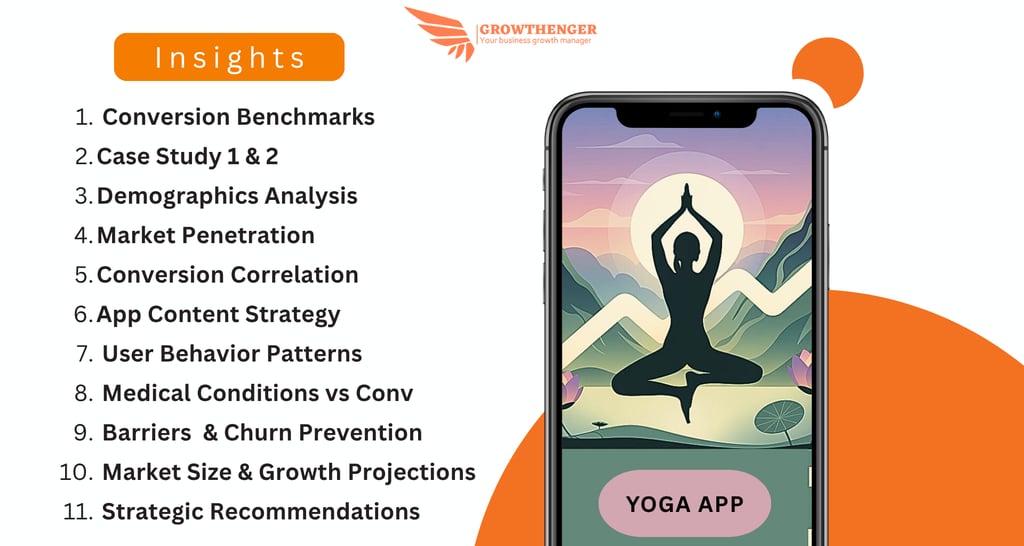Deep Dive: Optimizing Free Trial to Paid Conversion for Yoga Apps
This comprehensive analysis synthesizes data from major surveys spanning over 100,000 yoga practitioners across 124 countries, providing unprecedented insights into yoga app demographics, motivations, and conversion patterns.
APP MARKETING


Health & fitness apps show a median trial-to-paid conversion rate of 39.9%, with the top 10% converting at 68.3%
Yoga-specific case studies reflect lower baselines: We have seen conversions climb from 4.8% to 14% after implementing personalized messaging.
Yoga apps have boosted annual revenue by 16% and DAU by 19% through targeted engagement campaigns during trial and post-trial periods.
Main Takeaway: Yoga apps must focus on delivering rapid, personalized value and habit-forming experiences during the free trial, while addressing usage barriers, pricing perceptions, and billing friction to minimize cancellations and boost daily active users and paid subscribers.
Current Trial-to-Paid Benchmarks for Yoga & Fitness Apps
Why Users Drop Off After the Free Trial
According to SOSA 2025 data on subscription churn reasons:


Insufficient Usage (37%): Trial users often never experience the app’s core benefits—missing “quick win” asanas or personalized plans.
Cost Concerns (34.6%): Perceived value gaps—users don’t associate their usage with the subscription price.
Alternatives & Technical Issues: Competing free content (YouTube, social media) and crashes or poor streaming quality.
Billing Errors: Failed renewals lead to involuntary churn; Android devices especially prone to payment failures.
Core Challenges Facing Yoga App Businesses
Low Daily Habit Formation: Yoga requires routine; apps without built-in habit loops see trials fizzle.
Generic Onboarding & Lack of Personalization: One-size onboarding fails to address varied user goals (flexibility, stress relief, fitness).
Value Communication Gaps: Users aren’t shown premium content like guided flows or progress tracking early enough.
Pricing & Packaging Friction: Confusing tier structures and lack of mid-tier “decoy” plans reduce perceived affordability.
Billing Reliability & Transparency: Unclear auto-renewal terms and payment failures erode trust and cause surprise cancellations.
Strategies to Minimize Trial Cancellations & Maximize Daily Active Use
Drive Habit Formation
Micro-Commitment Challenges: 7-day “morning stretch” streaks with in-app badges.
Behavioral Segmentation: Push reminders timed to user’s preferred practice window (morning, lunch break).
Personalized, Value-First Onboarding
Goal-Based Flows: Ask 2–3 preference questions (experience level, focus area) to immediately tailor session suggestions.
Fast “Aha!” Moment: Unlock a 5-minute sample of a premium guided flow (e.g., “Calming Evening Wind-Down”) within 30 seconds of install.
Communicate Premium Benefits Early
In-Trial Paywall Nudge: After the first completed session, present an overlay highlighting unlocked sequences and community challenges.
Progress Visualization: Showcase a personalized calendar view of “Days Practiced” vs. “Days Left in Trial.”
Optimize Pricing Psychology
Three-Tier Decoy Structure: Free → Standard Monthly → Premium Annual (anchors high value).
Time-Limited Trial-End Offers: Automated email/push with 30% off annual plan delivered 48 hours before expiration.
Downgrade Options: Allow users to switch from premium to a lower-priced tier rather than full cancellation.
Enhance Billing & Trust
Grace Periods & Dunning: Enable Apple and Google play grace periods; send branded recovery emails on payment failures.
Transparent Auto-Renewal Notices: Push notifications and emails 3 days and 1 day before renewal.
User-Accessible Subscription Management: In-app links to manage or cancel subscriptions to reduce “surprise” churn.
Measuring Impact & Continuous Optimization
Key Metrics:
Trial start → first premium session completion
Trial engagement rate (% completing ≥3 sessions)
Trial-to-paid conversion
7-day and 30-day retention
Dunning recovery rate
A/B Testing Focus Areas:
Onboarding question flows vs. skip option
Paywall timing (post-first session vs. mid-trial reminder)
Discount depth (20% vs. 30%) and timing
Feedback Loops:
In-app surveys on trial cancellation reasons (triggered at moment of churn).
Qualitative interviews with churned users to refine messaging and pricing.
Yoga apps can close the gap between low-teens and 40–60% trial conversion by engineering habit-forming experiences, personalized onboarding, and transparent, user-centric billing flows. Focusing on usage activation within the first days, coupled with value communication and pricing psychology, transforms fleeting trial users into daily active yogis and loyal subscribers, unlocking sustainable growth and revenue. Wan to book a free app marketing consultation call with our experts?


